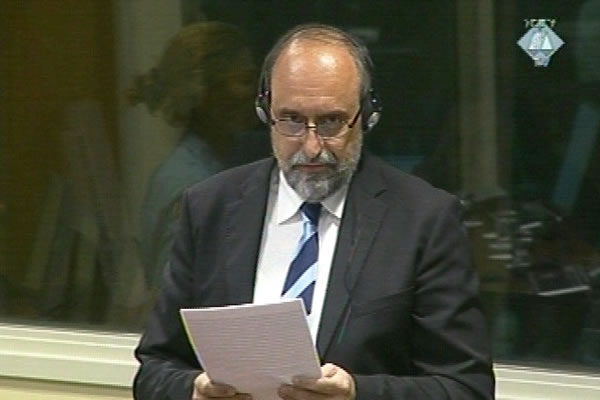Home
HOW THE WAR STARTED, AS SEEN BY GORAN HADZIC
In his evidence in his own defense Goran Hadzic talked about the establishment of the Serbian National Council, the deaths of Croatian police officers in Borovo Selo and his appointment as the prime minister elect of the ‘tentative’ government of the Serb Autonomous Region of Slavonia, Baranja and Western Srem
 Goran Hadzic in the cortroom
Goran Hadzic in the cortroom On the third day of his evidence in his own defense, former prime minister of the Serb Autonomous Region of Eastern Slavonia and the president of the self-proclaimed Republic of Serbian Krajina Goran Hadzic didn’t progress far from the beginning of the conflict in Croatia and the third paragraph of the indictment. Hadzic is on trial for crimes against humanity and war crimes in Eastern Slavonia from June 1991 to the end of 1993.
Hadzic began his historical outline last week with the description of the events in Pakrac and Plitvice. Today Hadzic continued with his testimony about the establishment of the regional Serbian National Council for Eastern Slavonia, Baranja and Western Srem on 7 January 1991. As Hadzic explained, the body was established to ‘articulate the views and demands’ of the Serb people in that territory.This body was independent from the Serbian National Council established in Srb in July 1990.
In his evidence Hadzic tried to distance himself from Milan Babic and the Serb leadership in Krajina. He insisted that unlike them his option advocated ‘living in a democratic state of Croatia because that was the only entity that could guarantee the protection and respect of ethnic rights’. Hadzic also argued that he ‘never received instructions from Belgrade, unlike the Krajina Serbs’. In the spring of 1991 he spoke about it in Belgrade with then US ambassador to the SFRY Warren Zimmermann.
Hadzic went on to describe the incident that occurred on 1 May 1991, when an ethnic Serb from Brsadin was killed as he ‘walked through the village to a picnic place carrying a Yugoslav flag’. Hadzic then presented his view of the events of 2 May 1991 in Borovo Selo when 12 Croatian police officers were killed.
In the morning he spoke with Slavko Degoricija, Croatian representative who was in charge of negotiating with the Serbs. Degoricija demanded that the roadblocks in Borovo Selo be removed. As soon as the road blocks were removed, the Croatian police entered Borovo Selo in two or three vehicles and two buses. Hadzic said that they opened fire, killing an unarmed guard who was sitting in front of the local community building. Another villager was injured. The police then ‘stormed’ the local community premises. According to Hadzic, the police leader then came to the infirmary, located at the ground floor, and took a child as a human shield. After that the conflict escalated: 13 persons were killed in total and many were wounded. The Croatian media claimed it was an ambush. In Hadzic’s view, that was not true. Tales told by some Serbian leaders to the effect that their volunteers from the Serbian Radical Party were in Borovo Selo that day are ‘an exaggeration’, Hadzic noted.
For more than an hour Hadzic testified in closed session. When the court went into open session again, the accused described how on 25 June 1991 the Assembly adopted the decision stating that the people of Slavonia, Baranja and Western Srem would remain in the Yugoslav state. Hadzic was appointed the prime minister elect of a ‘tentative future government’ which was supposed to promote the interests of the Serb population in Vukovar. Hadzic will continue his testimony tomorrow.
Linked Reports
- Case : Hadzic
- 2014-07-04 HADZIC DENIES CLAIMS MADE BY PROSECUTION WITNESSES
- 2014-07-03 GORAN HADZIC’S DEFENSE CASE BEGINS
- 2014-06-24 FOUR-DAY WORKING WEEK AND 140 HOURS FOR HADZIC’S DEFENSE
- 2014-07-08 ARMY HAD POWER, HADZIC HAD NONE
- 2014-07-09 HADZIC RENOUNCES BADZA AND ARKAN
- 2014-07-10 HADZIC AND JOINT CRIMINAL ENTERPRISE
